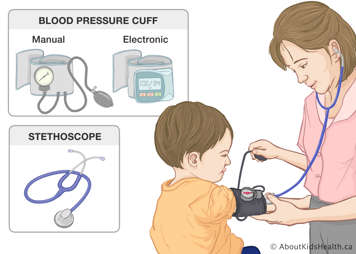What is blood pressure?
Blood pressure (BP) is a measurement of how hard the heart is working to push blood through the blood vessels.
There are two numbers in a blood pressure reading. An example of a blood pressure reading is 120/80 (say: 120 over 80).
- The top number (in this example, 120) is the systolic (say: siss-TOL-ick) pressure. It indicates the pressure of the blood flowing through the blood vessels when the heart is contracting and forcing the blood out.
- The bottom number (in this example, 80) is the diastolic (say: die-us-TOL-ick) pressure. It tells you the pressure of the blood flowing through the blood vessels when the heart is at rest.
Because your child's blood pressure tends to be high, you need to measure it at home. Learning how to measure your child's blood pressure will take a little time, but it is not difficult.

With your child's doctor or nurse, write in these instructions:
Take your child's blood pressure _______ times a day.
Your child's blood pressure readings should be between _________ and _________.
Readings above ________ are too high and readings below __________ are too low.
If your child has been given medication to help control blood pressure, it must be taken as prescribed, even when the blood pressure seems normal.
If your child's blood pressure is too low, DO NOT give the medication. Call your child's clinic right away.
Phone number of your child's clinic:
Name of contact person at the clinic:
Taking your child's blood pressure
Points to remember:
- Take your child's BP when your child is relaxed and rested.
- Take your child's BP just before giving blood pressure medication.
- Too much activity, excitement or nervous tension can cause a temporary rise in BP.
- If your child has symptoms such as headache, nausea, vomiting, dizziness and blurred vision, this may mean that your child's BP is too high or too low.
- About every six months, you should bring your BP cuff and stethoscope with you when you come to the clinic so that it can be checked for accuracy.
Equipment
You will need to buy a stethoscope and a BP cuff with a dial or an electronic BP cuff. Your nurse can help you decide. You will have to buy these before your child goes home so that you can learn to take BP with your own equipment. Your child's nurse will help you choose the right size and advise you where to shop for these items.
How to take your child's blood pressure
Your child's nurse will guide you through these steps that show you how to take your child's blood pressure.
- Have your child sit on a chair beside a table or lie down so that the child can rest their arm at heart level.
- Turn the screw beside the rubber bulb to the left to open it. Squeeze the air out of the cuff.
- Place the cuff on your child's upper arm above the elbow, with the Velcro edges facing out. Make sure the dial is face up so that you can see it easily. Wrap the cuff firmly around your child's arm. Fasten the Velcro edges and padded parts together.
- Place your first and second fingers on the inner part of your child's elbow and feel for a pulse. Place the flat part of the stethoscope on the spot where you feel the pulse, then put the earpieces in your ears.
- Turn the screw beside the rubber bulb to the right until it is firmly closed.
- Watch the dial and pump the bulb of the cuff with one hand until you can no longer hear the pulse.
- Slowly open the screw until you hear the first pulse sound. Remember the number the needle is pointing to on the dial when you hear the first pulse sound. That number is the systolic pressure, the top number on a blood pressure reading (for example, 120/ ).
- Keep watching the dial and slowly continue to release the screw until you hear the pulse sound change from a loud thumping to a soft sound or until the sound disappears. Note the number on the dial when you hear the soft sound or no sound. That number is the diastolic blood pressure, the lower number in a blood pressure reading (for example, /80).
- Record the complete blood pressure reading (for example, 120/80) in a diary.
Keeping records
Always write down your child's BP reading and bring all of your child's blood pressure records with you when you have an appointment with your child's doctor or the clinic.
What to do if your child's blood pressure is too high
Blood pressure medication, even when given regularly, may not be enough to keep the BP within the normal range. Your child may be prescribed a "prn" dose of BP medication, which means a dose taken as the need arises.
When your child's BP reading is too high:
- Make sure that your child is calm and rested.
- Check your child's BP again after 20 to 30 minutes. If it is still too high, give the prn medication.
- If the BP does not come down within 45 minutes after giving the prn medication, please call your child's clinic.
What to do if your child's blood pressure is too low
- Have your child lie down and rest.
- If it is time to give your child a dose of BP medication, DO NOT GIVE IT.
- Take your child's BP again in 15 minutes.
- If the blood pressure remains too low, or if your child looks unwell, call your child's doctor or clinic for advice.
